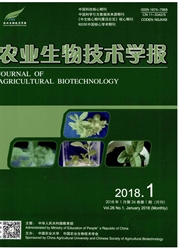

 中文摘要:
中文摘要:
芒草(Miscanthus Anderss)被认为是生物质产量高、资源利用率高、生产成本低、环境适应性广、开发潜力大的纤维素类能源植物,芒(M.sinensis)是其中的一个种.本研究以不同基因型芒的成熟种胚与下胚轴为外植体建立了高效离体培养再生体系,测定了不同基因型芒茎秆的细胞壁木质纤维素组分、纤维素及半纤维素的降解效率.结果表明,不同基因型芒在胚性愈伤组织诱导及分化效率、分蘖力等方面存在显著差异,且胚性愈伤组织在继代过程中均存在生根的现象,阻碍了分化;不同基因型芒的茎秆细胞壁组分、纤维素及半纤维素降解率均存在显著差异.胚性愈伤组织诱导及分化与芒的茎秆细胞壁的木质纤维素组分及其降解效率没有明显的相关性.综合生物学性状、细胞壁组分及其转化效率、胚性愈伤组织诱导及分化效率等指标,本研究确定PMS 167为适合用于纤维素燃料乙醇研究的理想基因型.研究结果为芒草通过遗传转化途径定向遗传改良、良种快繁提供了良好的技术平台.
 英文摘要:
英文摘要:
Given great biomass yield, high composition of lignocellulose, high use efficiency of feedstock, low cost, wide adaptability, Miscanthus has great potential as an excellent bioenergy crop. M. sinensis is one of the species. This study established an efficient system by using the matured seeds' embryo and hypocotyl as explants. Significant variations were determined for the efficiency of embryogenic callus production, regeneration, tillering, cellulose and hemicellulose contents, lignin content, cellulose and hemicellulose degradation efficiency in a diverse of M. sinensis genotypes. Additionally, rooting was found during the subculture in all genotypes, which inhibited the regeneration. No significant correlation was detected between the efficiency of embryogenic callus production, regeneration and the lignocelluloses component and their degradation efficiency. For its agronomic traits, lignocelluloses feature and tissue culture result, the genotype, PMS167, was considered as model feedstock of cellulose ethanol. The study is informative for the genetic improvement and efficient micropropagation for Miscanthus.
 同期刊论文项目
同期刊论文项目
 同项目期刊论文
同项目期刊论文
 期刊信息
期刊信息
